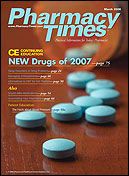Publication
Article
Pharmacy Times
Read Back Helps Avoid Errors with Sound-alike Medications
Author(s):
To avoid medication mix-ups, all practitioners should be encouraged to have orders read back and spelled out.
Dr. Gaunt is a medication safetyanalyst and the editor of ISMPMedication Safety Alert!Community/Ambulatory CareEdition.
Salagen?Selegiline Sound-alike Mix-up
A home health nurse received a telephoneorder from a dentist for an elderlypatient experiencing problemsrelated to dry mouth. The order was forpilocarpine (Salagen) 5 mg po tid. Whenthe nurse telephoned the pharmacist,however, the order was misheard andwas dispensed as selegiline 5 mg potid. Selegiline is a selective inhibitor ofmonoamine oxidase type B used in thetreatment of Parkinson's disease.About 2 weeks later, another pharmacistwas processing a fentanyl patchprescription for this patient, when thepharmacy computer system issued analert about a drug interaction betweenfentanyl and selegiline. The error wasrecognized when the pharmacist contactedthe prescriber about this interaction.
Sleep or Psychosis?
A nurse took a verbal order from aphysician for "Risperdal 15 mg at bedtimeprn sleep." The order was thentelephoned into the pharmacy. Thepharmacist, aware that risperidone(Risperdal) is an antipsychotic, recognizedthat the order did not make senseand questioned the nurse, who confirmedthat Risperdal is what she heardthe physician say. Not satisfied with theanswer, the pharmacist insisted on clarifyingthe order directly with the physician—which revealed that the orderhad been misheard and was actually fortemazepam (Restoril) 15 mg.
No Help for Depression
By telephone, a physician orderednortriptyline (Pamelor) 75 mg to beadded to his patient's medication regimen,which also included sertraline(Zoloft) 150 mg. A pharmacy technicianwho received the order (in a statewhere this is allowed) misheardPamelor as Tambocor (flecainide), andthe prescription was dispensed assuch. The patient took Tambocor, anantiarrhythmic, for 1 month and thencalled the physician's office for a refill.At this point, the office staff realizedthat a dispensing error had occurredwith these similar-sounding drugnames. The patient complained of fatiguebut had no specific cardiovascularsymptoms. The medication wasstopped, and the patient suffered noharm.
Safe Practice Recommendations
To avoid mix-ups related to sound-alikemedications, all practitionersshould be encouraged to use a processknown as "read back" on every orderthat is communicated verbally or bytelephone. With read back, an order isfirst transcribed directly onto the chartor prescription blank as it was understoodand then read back (or evenspelled back for unfamiliar or sound-alikenames such as these) to verify thecorrect interpretation. Unfamiliar andsound-alike drug names should bespelled out.
This is a requirement for those workingin long-term care or home careoperations accredited by the JointCommission on Accreditation ofHealthcare Organizations, but all practicesites should consider implementingthis important safety step.
The typical lack of access to clinicalpatient information by ambulatory carepharmacists also plays a role in thesetypes of mix-ups—which is why it is soimportant for prescribers to indicateeach medication's purpose when communicatingorders to the pharmacy. Ifthe purpose is not communicated,pharmacists should inquire about itwhen accepting the order. In addition,pharmacists should insist on speakingdirectly to the prescriber if doubt stillexists after speaking with a nurse orother office delegate.
Often, the pharmacist's only accessiblesource of the medication's indicationis the patient. For this reason, theimportance of patient counseling cannotbe overstated.







